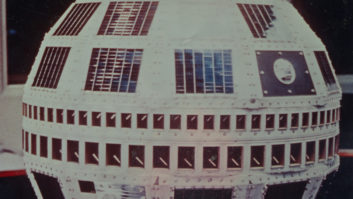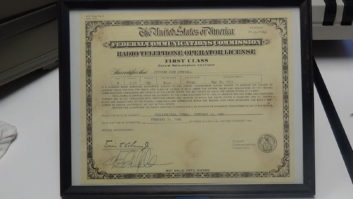
“Diode Modulation” is a simple means of creating an AM signal. The exciter creates the carrier. Audio is combined to create amplitude and sidebands and then sent to a half-wave rectifier. This signal is then injected into the grid of the tetrode final amplifier where the modulation envelope is created at full power. The 1960s started the age of solid-state development. Groundwork for transistors and diodes had been laid with new applications being developed almost daily. Integrated circuits evolved into opamps; then early microprocessors were being developed. Most early solid-state circuits were low voltage and low current, relying on vacuum tubes for major amplification to drive speakers, or send signals to an antenna.
At one point, RCA developed a vacuum tube that had all of the identification characteristics of a transistor. They called it the Nuvistor, capable of operating in the VHF and UHF band where junction transistors did not perform well.
This was the hybrid era of electronics. Broadcast transmitters relied almost totally on vacuum tubes for final amplification. The tubes were rugged and had a long life when maintained properly. Solid-state started to creep in with the use of diodes rather than mercury vapor tube rectifiers.
Field-effect transistors entered the commercial market. The FET could operate in the VHF and UHF bands without the appearance of being a short circuit. FETs could be used in radio frequency applications. However, the workhorse for amplification was still the vacuum tube — in AM, quite a few tubes were needed to handle high-level modulation and the final amplifier.
VANGUARD
Times were changing and through its Gates transmitter line, Harris took a bold step in marketing an all transistor plus one-tube 1 kW AM transmitter.
It used low-level modulation, an unusual method for that era. They named it “Vanguard.” A low-power “exciter,” an unusual term back then for an AM transmitter, employed “diode modulation” to feed a 4CX3000A ceramic tetrode vacuum tube operating as a class-B linear radio frequency final amplifier.
If the antenna system was in good condition, permitting the Vanguard to be matched properly, it ran without problems delivering excellent frequency response. The efficiency of the final amplifier was low, only about 35 to 40 percent but compared to vacuum tube transmitters requiring class AB modulators, final amplifiers and other vacuum tubes, the operating cost of running the Vanguard was reasonable. However, the cost of electricity was low, and there were legions of broadcast engineers who were leery about the life span of transistors in an environment where reliability was paramount.
In addition, the Vanguard was more expensive than the traditional tube transmitters.
It was not a leader in sales for Harris.

The Seeburg Jukebox, which the author speculates may have inspired the transmitter’s design.FUTURISTIC DESIGN
The first Vanguard was produced in 1966 and had a space age look. If the Jetsons had owned a radio station, they would have had a Vanguard transmitter.
Many thought it looked like something Gates designed with help from Maytag or KitchenAid. Some DJs actually probably believed that. The original design was only about chest high, and staff would use the exhaust chimney from the vacuum tube to reheat pizza, sandwiches or anything else, creating quite a mess for engineers to clean up. I always thought that Harris/Gates teamed with Seeburg Jukebox when designing the Vanguard.
As with all things, the Vanguard was revised and improved and redesigned to fit in one of the BC series transmitter cabinets. No more using it for a hotplate.
My experience with the transmitter came in the mid-’70s. I was hired at WOHO in Toledo to take care of the directional antenna. That position expanded into all areas of station maintenance but most of my responsibility was checking the operating log, taking monitor point measurements and calculating antenna ratios to make sure the station was in compliance with its license for its day and night patterns.
I would also check WXEZ(FM) on a weekly basis. WOHO had a Vanguard II.
For quite some time, I didn’t pay any attention to the Vanguard transmitter. It ran flawlessly almost all the time I was there. Then in the summer of 1977 just before I would leave Ohio and move to Virginia, a problem arose. The transmitter started losing output power and the raise/low power adjustment didn’t correct anything. I checked the transmitter manual and found an issue with the power output adjustment coil in the exciter.

The Vanguard
credit: Mike Monnier, W8BAC.com This coil was frequency sensitive, chosen by Harris/Gates for the transmitter carrier frequency. Vibrations in the transmitter loosened a screw adjustment, and it could not be locked in place. It was night, and I made a quick fix, gluing the set screw in place with a drop of Krazy Glue. I then called Harris.
By the mid-’70s, there were not many people in Bloomington who knew anything about Vanguards. The transmitter had been out of production for seven years. The person I spoke to knew little about the problem. He mentioned that they had an exciter that was still on the shelf that he could sell the station. I declined the offer for such a purchase for a transmitter of that age.
I notified the management of the problem and prepared to move. By this time transmitter design had advanced to more efficient Pulse-Width Modulation systems and ultimately FET all-transistor transmitters.
The Vanguard, as its name suggests, was in the forefront of solid-state transmitter design. By 1969 the Vanguard was no longer offered in the Gates/Harris catalog. The Vanguard occupies a small space in broadcast history, but it was an innovation that advanced solid-state transmitter design spurred by the development of the family of Field-Effect Transmitters.
I returned to Toledo a year later and visited WOHO to find the Vanguard II still performing as the main transmitter. The Krazy Glue was still probably holding the coil in place.
The author is a longtime technology communications educator and Radio World contributor.
What piece of equipment do you recall with fondness or dread? Why? Email[email protected]with Letter to the Editor in the subject line.











